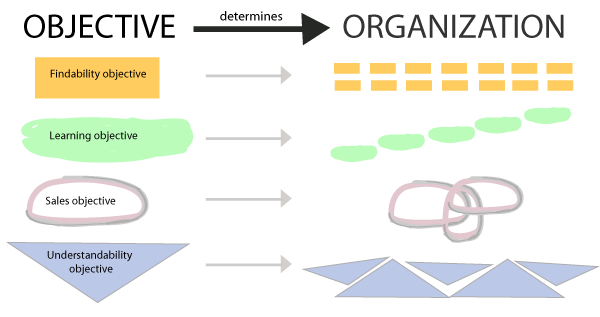Eight Defining Questions that Shape Content Organization [Organizing Content #29]
With recent posts in this series, I started to raise a different question. Rather than asking, how can I help users find this information, I started to ask, how can I help users learn this information? The question you ask determines the strategy you use to organize your content.
This may seem like an obvious point, but it's fundamental in determining how to organize your content. In looking over different tech-comm-related disciplines, there are at least 8 different questions we are likely to ask:
- How can I make this content understandable? (technical writing)
- How can I make this content findable? (information architecture)
- How can I improve the content and the processes surrounding the content? (content strategy)
- How can I help users learn the content? (instructional design)
- How can I manage and re-use the content? (content management)
- How I persuade the audience toward a particular view of the content? (rhetoric)
- How can I make the application more usable? (user experience)
- How I can I increase sales and adoption of the application? (marketing)
(Let me know if you disagree about these questions, by the way. I find that distilling a discipline down to one central question helps me better understand what the discipline is all about.)
Each of these questions informs or shapes how one should organize the content. This is just common sense. Your content's organization should reflect your objective. If your objective is to help users learn the content, you'll choose a different organization than if your purpose is to make the content findable.

For example, a learning objective may prompt you to chunk the material into 5 minute learning modules, with a focus on only the most common tasks. You might then break out the modules into levels that users can proceed through.
But if your objective is to make the information findable, you may have a different organization. You might have different navigation facets that the content is tagged with. Those facets can form the navigation on the homepage. As users drill into the facets, a second-level navigation might appear.
If your purpose is to make the application more usable, you might focus most of your energies around interface text, context-sensitive help, information pop-ups, error messages, navigation text, button labels, dialog boxes, and other helps the user will see while in the application.
If your purpose is understandability, you might focus more of your efforts on illustrations, screencasts, screenshots (with callouts and captions). You might carefully structure the content in a hierarchical way, and use bulleted lists, subheadings, examples, and other aids to help make it easy for the user to understand.
It's more problematic, though
This may seem all like common sense, but the reality is much more problematic. Technical communicators often have multiple purposes. If you distinguish a technical writer from an instructional designer with the two questions above, one may want to punch the other. The purposes overlap. Of course technical writers want to help users learn the application. Of course instructional designers want users to understand the content. Who doesn't want to improve the content and make the processes surrounding content creation, approval, and delivery more efficient? Who wouldn't be interested in improving the user experience in the application? Technical communicators do all of this.
Do competing objectives have mutually exclusive organizational models for the content? Can I satisfy multiple purposes with the same content organization? To some extent, yes. But that's where it becomes challenging. Maybe the information architect's question becomes the most important one to ask -- how can I help the user find the content he or she needs based on differing purposes? How can I present the material to the user in the right way at the right time to fill my current objective? If one user wants to learn, another wants marketing material to sell the app to his or her department, another user wants to find an answer to an obscure question -- how can we organize the content to meet all of these needs?
To further explore this question, I'll probably need to move from the abstract to the concrete and apply it to my initial Swordfish project scenario.
About Tom Johnson

I'm an API technical writer based in the Seattle area. On this blog, I write about topics related to technical writing and communication — such as software documentation, API documentation, AI, information architecture, content strategy, writing processes, plain language, tech comm careers, and more. Check out my API documentation course if you're looking for more info about documenting APIs. Or see my posts on AI and AI course section for more on the latest in AI and tech comm.
If you're a technical writer and want to keep on top of the latest trends in the tech comm, be sure to subscribe to email updates below. You can also learn more about me or contact me. Finally, note that the opinions I express on my blog are my own points of view, not that of my employer.
